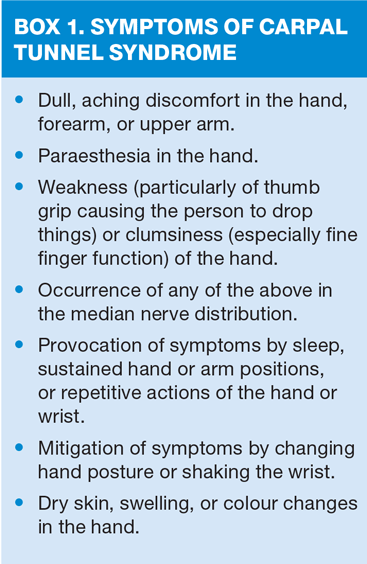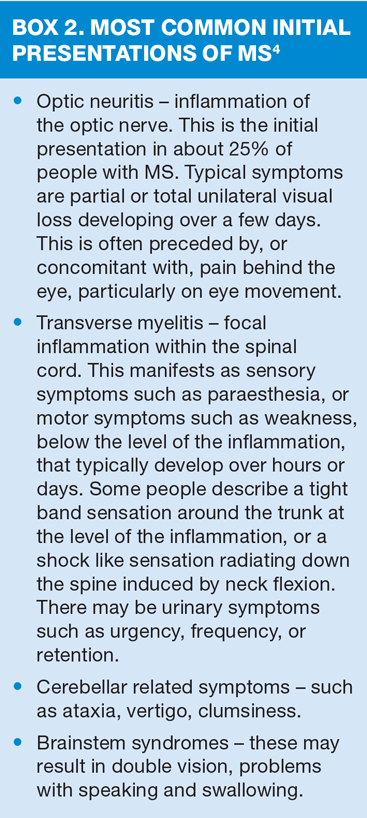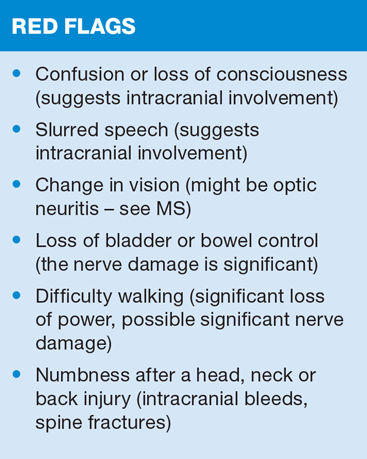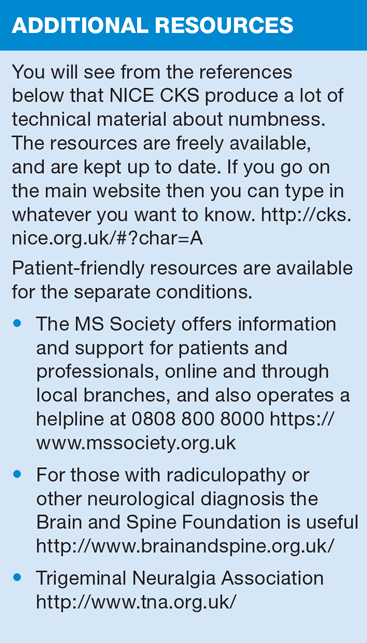Neurological symptoms in primary care Part 2: Numbness
Dr Ed Warren
Dr Ed Warren
FRCGP, FAcadMEd
Lack of knowledge of neurological symptoms can lead to failure to recognise conditions that may require rapid referral and treatment. In this series we look at commonly presenting signs and symptoms, explore their possible causes and flag up those that need urgent attention
Numbness is a rather imprecise term for having an abnormal sensation. The sensation may be altered or completely absent. The most commonly affected parts are the extremities (hands and/or feet), but numbness can arise anywhere. The parts affected also give an idea of the likely cause of the numbness.
Numbness is frequently associated with tingling or pins and needles (paraesthesia) in the affected part. This sensation can be so severe that it is experienced as actual pain. Anyone who has woken in the night with their arm feeling dead will have been mightily relieved when the offending limb is restored after a minute’s shaking.
The symptom of numbness is caused by a sensory nerve not working as it should. Reasons for this to occur are many and various: one website aimed at patients suggests at least 50 different reasons.1 That numbness and tingling is caused by a nerve disorder is not widely appreciated, and anecdotally it is not uncommon for people with numbness to conclude that they have a circulation problem. A paper from 2008 looked at patients with type 2 diabetes presenting in primary care with an ulcerated foot lesion. It was only a small sample (18), but this is understandable as each was subjected to an in-depth interview. The general perception was that reduced blood supply to the feet was the primary cause of foot complications in diabetes.2 As this perception about the cause of numbness is so widespread, care must be exercised when offering explanations and suggesting management plans so that you achieve concordance with your patients about what should be done. It gets even more complex because limb ischaemia can cause numbness as well as pain, and stroke (which is definitely a circulation problem) often results in numbness or altered sensation on the affected side.
SOME CAUSES OF NUMBNESS
You will possibly be relieved to learn that this article will not be discussing 50 different reasons for numbness. Some causes are relatively commonly seen in general practice, and these are the ones to be focused on. Patients with more esoteric reasons for their symptoms may well end up being sent to a neurologist anyway, so that an ability to confirm a diagnosis is not crucial, as long as you can be sure that your patient will not die while they are waiting.
For each diagnosis the nature of the altered sensation, its manner of onset, the presence of associated symptoms, and the distribution of symptoms will offer an indication of the possible cause.
Anything related to disorders of the nervous system carries attendant fears for the sufferer. How can you be sure it is not a stroke, or a brain tumour, or multiple sclerosis? Whatever other symptoms your patient brings to talk about, he or she will also be anxious.
CARPAL TUNNEL SYNDROME
Carpal tunnel syndrome occurs in around one in 40 men and one in 20 women at some time of life, the peak ages being 45 to 64 years.3 It is caused by pressure on the median nerve at the wrist – this is the one that takes sensation from the thumb and the first two fingers, and also the outside half of the ring finger (looking at the palm of the hand), so it is here that the numbness and tingling and pain is felt. The cause of the increased pressure is unknown in most people, but exposure to vibration or repetitive wrist movements may contribute.3 If pressure persists, then this impairs the blood supply to the median nerve which may result in permanent nerve damage – severe painful symptoms and muscle wasting (wasting typically of the thenar eminence, that lump of muscle at the base of the thumb on the palm side).
Symptoms can occur in one or both hands. They tend to be worse at night, and a typical story is that your patient is woken from sleep and has to shake the offending extremity (extremities) vigorously to relieve the distress. Box 1 gives a list of symptoms of carpal tunnel syndrome – the more symptoms that are present the more likely is the diagnosis to be confirmed.
A way of confirming carpal tunnel syndrome is Phalan’s test: flexing the wrist at 90 degrees for 60 seconds will make symptoms worse. (George S Phalen was an American hand surgeon 1911-98).
Symptoms tend to resolve after about 6 months. Sometimes there is an underlying cause, such as pregnancy, hypothyroidism or a reason for fluid retention. For others it may be apparent that a particular activity is making things worse – if it hurts then stop doing it. Splinting the wrist with a light removable splint helps 50% of people. Using the splint just at night is usually recommended but it works better if it is used night and day, for 12 weeks.3 Drug treatment does not usually help, and is no longer recommended.3 And if all this fails, then your local hand surgeons will be able to confirm the diagnosis using electromyography, and may suggest a steroid injection beside the median nerve, or else a surgical decompression of the area around the nerve.
MULTIPLE SCLEROSIS
Multiple sclerosis (MS) is mentioned here, not because it is particularly common (about one in 800 people in England and Wales have MS4) but because it is understandably a feared diagnosis, and strikes people down at a young age (the average age of onset is 30 years4). Women are affected three times as often as men.
MS invariably affects more than just sensation. The underlying problem is thought to be autoimmune: this causes inflammation and damage to nerve fibres which causes the symptoms. It is not known why the process starts. However, altered sensation (numbness) in arms or legs, or on another patch of skin, may be the earliest indication that MS is starting.1 MS is frequently relapsing and remitting, so that early symptoms often resolve making it appear that the problem has gone away. Accordingly we have a condition that can cause numbness, that has a poor prognosis, and for which treatments are at best disappointing: the potential for MS to provoke fear is huge.
Box 2 lists the most commonly presenting MS symptoms. In the early stages, symptoms may be confined to numbness (often with paraesthesia), perhaps a wobbly gait (due to reduced muscle power and altered sensation in feet), and perhaps double vision or blurred vision.
NEUROPATHY
Neuropathy simply means that something is wrong with a nerve, so unsurprisingly numbness may be the result. Strictly, any part of the body (including internal organs) can be affected, but the majority of neuropathies are peripheral, and they affect the feet or (less commonly) the hands.
The commonest reason for neuropathy in the UK is diabetes. Around a quarter of people with diabetes have neuropathy as a consequence.5 The numbness is invariably associated with pain and is felt mainly in the feet and lower legs, usually worse at night. The emergence of neuropathy may occasionally be the first symptom of diabetes, and checking HbA1c is a normal part of the tests done for peripheral neuropathy in patients not known to have diabetes.
However, diabetes is not the only reason for neuropathy. It is a problem seen mainly in people over 40 years old, and may also be precipitated by chronic kidney disease, hypothyroidism, and vitamin deficiency (especially B12).1
NEURALGIA
No discussion of numbness would be complete without mentioning neuralgia: a nerve problem where only one nerve is affected. Accordingly symptoms are confined to a limited area of skin, the area served by the culprit nerve.
Postherpetic neuralgia is the consequence of an episode of shingles, and affects the area where the rash was present. Unfortunately symptoms can continue for weeks or months after the rash has gone. Numbness is the least of the patient’s problems as the associated pain is usually more distressing.
Trigeminal neuralgia affects just one side of the face and is a problem particularly of the over 40s and females.6 Pain comes in episodes, often fleeting (seconds or minutes) and multiple, which may be provoked by going out in the wind or by eating or face washing. Again, pain is more of a feature than numbness.
RADICULOPATHY
Radiculopathy is the term used to describe when a nerve is trapped as it emerges from the spine, causing pain and numbness in the body part that the nerve serves. Some patients find this a bit hard to grasp, and will feel sure, for example in sciatica, that it is the leg that is causing the problem rather than the back, because it is the leg that hurts.
Sciatica occurs when a nerve root is trapped in the lower back. Pain and numbness are felt down the back of the leg, often as far as the foot. (This is where the sciatic nerve runs to: there are other conditions when other nerves are affected, and these give symptoms in different parts of the leg). About 5% to 10% of people with back pain will also have sciatica, and the lifetime prevalence is between 12% and 43%.7 In 90% of cases the underlying problem is a herniated intervertebral disc (‘slipped disc’).7 If you work in an area of heavy industry (past or present), backache will be virtually universal for your patients from middle age onwards, and the population will be well used to family members or friends with sciatica.
The other common place for nerve root entrapment is the neck. If the lower neck is involved, numbness, pain and muscle weakness are felt in the lower neck, shoulder and possibly arm, usually just on one side of the body. If the upper neck is involved, symptoms can occur in the head (usually at the back) or face. Again a common reason for the condition is intervertebral disc herniation, but just osteoarthritis by itself can also be a cause.8 The majority of men over age 50 and women over age 60 have X-ray evidence of neck osteoarthritis,9 but only a small proportion will have radiculopathy symptoms.
OTHER CAUSES
You may come across patients with numbness and tingling from the elbow to the little-finger side of the hand. This can be due to trapping of the ulnar nerve – the ‘funny bone’ on the inside of the elbow. Heavy users of alcohol may get numbness in the hands and feet, possibly due to vitamin deficiency. People prone to episodes of panic may experience total body numbness, but they will also experience other symptoms.
Some features of numbness, or symptoms associated with numbness, will alert you that a serious and urgent disease process is occurring.10 See ‘Red flags’.
CONCLUSION
Careful assessment of patients complaining of numbness, and a detailed history, can help to ensure that they are reassured, referred to the GP or to secondary care in a timely way, bearing in mind that even when there is no immediate cause for alarm, these symptoms can be distressing and may be related to an underlying disease requiring further investigation.
REFERENCES
1. Krukic G. What causes numbness? 50 possible conditions. http://www.healthline.com/symptom/numbness
2. Gale L et al. Patients’ perspectives on foot complications in type 2 diabetes: a qualitative study. Br J Gen Pract 2008; DOI: 10.3399/bjgp08X319657
3. NICE CKS. Carpal tunnel syndrome. http://cks.nice.org.uk/carpal-tunnel-syndrome
4. NICE CKS Multiple sclerosis. http://cks.nice.org.uk/multiple-sclerosis [
5. NICE CKS Diabetes – type 2. http://cks.nice.org.uk/diabetes-type-2
6. NICE CKS Trigeminal neuralgia. http://cks.nice.org.uk/trigeminal-neuralgia
7. NICE CKS Sciatica (lumbar radiculopathy). http://cks.nice.org.uk/sciatica-lumbar-radiculopathy
8. NICE CKS Neck pain – cervical radiculopathy. http://cks.nice.org.uk/neck-pain-cervical-radiculopathy
9. Tidy C. Cervical Spondylosis. PatientPlus. http://patient.info/doctor/cervical-spondylosis-pro
10. Mathukia M. Red flag symptoms: numbness. GP online 6 November 2009 http://www.gponline.com/red-flag-symptoms-numbness/cv-thromboembolic-disorders/cerebrovascular-accident-stroke/article/949762
Related articles
View all Articles



